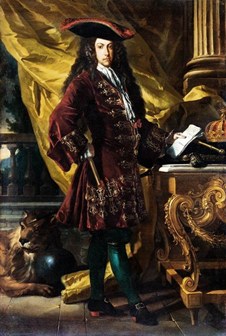Archduke Charles of Habsburg – Emperor Charles VI
 Charles of Habsburg (1685-1740) was the second son of Emperor Leopold I. In 1700, after the death without heirs of Charles II of Habsburg, he proclaimed himself king of Spain to reaffirm the position of the family on the Iberian throne. The result was the War of the Spanish Succession, in which he was opposed Philip of Anjou, the grandson of Louis XIV of France and heir to the throne designated by the deceased sovereign. Backed by an international coalition opposed the installation of the Bourbons to the Spanish throne, Archduke arrived in Spain in 1704 as King Charles III and remained there for the next seven years. In 1711, after the death of his older brother Joseph I, however, he had to return to Germany to be crowned as Holy Roman Emperor Charles VI. He lost the Spanish Crown following the Treaty of Utrecht (1713) and Rastadt (1714). Many years later, Charles was at the origin of another War of Succession: his death without male heirs unleashed a fierce conflict, at the end of which his eldest daughter Maria Theresa took the throne of Austria (the War of the Austrian Succession, 1741-1748).
Charles of Habsburg (1685-1740) was the second son of Emperor Leopold I. In 1700, after the death without heirs of Charles II of Habsburg, he proclaimed himself king of Spain to reaffirm the position of the family on the Iberian throne. The result was the War of the Spanish Succession, in which he was opposed Philip of Anjou, the grandson of Louis XIV of France and heir to the throne designated by the deceased sovereign. Backed by an international coalition opposed the installation of the Bourbons to the Spanish throne, Archduke arrived in Spain in 1704 as King Charles III and remained there for the next seven years. In 1711, after the death of his older brother Joseph I, however, he had to return to Germany to be crowned as Holy Roman Emperor Charles VI. He lost the Spanish Crown following the Treaty of Utrecht (1713) and Rastadt (1714). Many years later, Charles was at the origin of another War of Succession: his death without male heirs unleashed a fierce conflict, at the end of which his eldest daughter Maria Theresa took the throne of Austria (the War of the Austrian Succession, 1741-1748).
Read more:
-
P. Alatri, L’Europa delle successioni (1731-1748), Palermo 1989.
-
R. Browning, The War of the Austrian Succession, London 1995.
